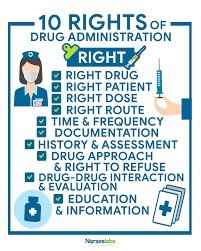A nurse administers an incorrect dose of medication to a client. The nurse recognizes the error immediately and completes an incident report. Which of the following facts related to the incident should the nurse document in the client's medical record?
Completion of the incident report
Time the medication was given
Reason for the medication error
Notification of the pharmacist
The Correct Answer is B
A is incorrect because the completion of the incident report should not be documented in the client's medical record, but in a separate file for quality improvement purposes.
B is correct because the time the medication was given is an essential fact related to the incident that should be documented in the client's medical record.
C is incorrect because the reason for the medication error should not be documented in the client's medical record, but in the incident report for analysis and prevention of future errors.
D is incorrect because the notification of the pharmacist should not be documented in the client's medical record, but in the incident report for follow-up and corrective actions.

Nursing Test Bank
Naxlex Comprehensive Predictor Exams
Related Questions
Correct Answer is A
Explanation
- A. Correct. The nurse should turn off the CPM machine during mealtime to allow the client to eat comfortably and prevent aspiration.
- B. Incorrect. The nurse should maintain the client's affected hip in a neutral position to prevent dislocation of the prosthesis and promote healing.
- C. Incorrect. The nurse should not instruct the client how to adjust the CPM settings for comfort, as this could interfere with the prescribed range of motion and speed of the device. The nurse should notify the provider if the client reports discomfort or pain.
- D. Incorrect. The nurse should not store the CPM machine under the client's bed when not in use, as this could pose a safety hazard and damage the device. The nurse should place the CPM machine on a stable surface away from the bed.
Correct Answer is D
Explanation
The correct answer is D
Choice A Reason: While croup can be serious, an O2 saturation of 92% on room air is generally stable. This child's condition is concerning but not immediately life-threatening.
Choice B Reason: A 15-year-old adolescent who is 2 hours postoperative following an open reduction and internal fixation of the left ankle and is requesting pain medication is in need of comfort measures. Postoperative pain management is important for recovery, but it is not a priority over more critical conditions.
Choice C Reason: A 3-year-old toddler with gastroenteritis, moderate dehydration, and two loose bowel movements over the past 24 hours requires rehydration and monitoring. The normal range for bowel movements varies, but two loose stools in 24 hours for a toddler with gastroenteritis is not unusual. Dehydration can become severe, so this child should be assessed soon, but it is not the most urgent case.
Choice D Reason: This child's sudden relief from pain could be a sign of a perforated appendix, a serious complication that requires immediate medical attention. Therefore, this child's condition is the most urgent and requires immediate assessment.
Whether you are a student looking to ace your exams or a practicing nurse seeking to enhance your expertise , our nursing education contents will empower you with the confidence and competence to make a difference in the lives of patients and become a respected leader in the healthcare field.
Visit Naxlex, invest in your future and unlock endless possibilities with our unparalleled nursing education contents today
Report Wrong Answer on the Current Question
Do you disagree with the answer? If yes, what is your expected answer? Explain.
Kindly be descriptive with the issue you are facing.
